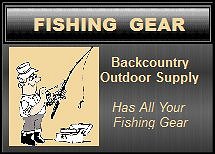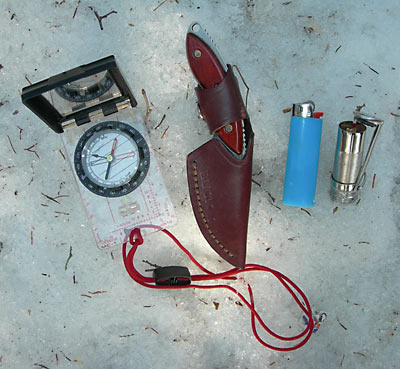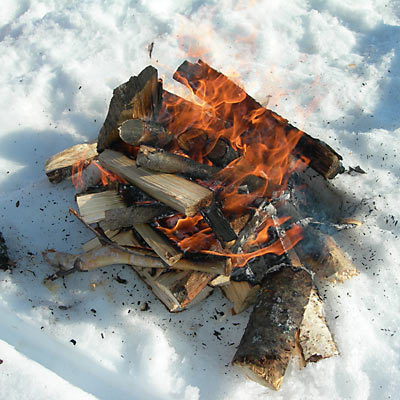The country's premier hunting and fishing daily news
The Backcountry Press
The Backcountry Outdoor News reports the latest hunting & fishing news along with fishing derbies & tournaments
from:
| ||||||
| ||||||
|
Hunter Safety
Surviving Mother Nature: Remember the FSFS Rule
Submitted by: Backcountry Outdoor News
© 2010 Backcountry Press Outdoor News - All Rights Reserved
BACKCOUNTRY PRESS is the country's premier daily hunting, fishing & outdoor news in the USA, Canada and more. Read whats happening in your neck of the woods & beyond.
For those who provide updated information in the field of hunting & fishing, please don't hesitate to contact us to get
your articles added to our site.
Loading
Disclaimer: The views expressed on this site are that of the authors and not necessarily that of The Backcountry Press Outdoor News
Along with this, is the necessity to gather an adequate supply of wood to keep that fire going, particularly throughout the night. Experts recommend collecting about three times as much firewood as you think you will need to get through the night because a fire generally burns much faster than anticipated. Gathering and burning tall but dead and dry trees of an approximate five to eight-inch diameter from one end to the other is an effective way to keep from having to continually search for more fuel. Don't worry about cutting or breaking them into small pieces, but rather pile up one end as your fire in front of the shelter and spread out the opposite ends away from the flame so that they won't burn.
One of the most important considerations is where to establish your fire. If you have a limited ability to start a fire (i.e. only or two matches for instance), you may need to keep it going around the clock. In an ideal situation, build your fire with the location of your shelter in mind. Consider prevailing winds and offset the angle of the fire and shelter so that the wind is blocked by the shelter but also so that the smoke is carried away from the shelter and neither directly into it or back-draft into it. In the best case scenario, the fire will be placed within two or three feet of the entrance of the shelter for easy access and to capitalize on the heat given off by the fire.
"S" - Shelter
Almost as important is a shelter. Exposure is your enemy. Without cover from the elements, it's only a matter of time before extreme cold temperatures and/or wind will take its toll. By finding or constructing a shelter, we can protect ourselves. Without shelter, small problems can become big ones in a hurry. A person that is lost must determine a way to protect themselves from wind, rain, snow and, yes even the sun. Exposure to harsh environmental conditions can be exhausting launching the victim into a hypothermic state or otherwise causing physical strength to be drained. In a survival situation it is absolutely imperative to retain as much strength as possible.
Shelters don't have to look or feel like the Hilton but they do need to offer protection, be sturdy, and be as comfortable as possible given the circumstances. In old-growth boreal forests shelters are not usually a problem. A lean-to can be easily constructed using a strong cross bar with structural branches as a frame and a layered coating of spruce bows to repel precipitation and offer shade. Likewise smaller spruce bows can be used to line the base for a bed. In a survival situation creativity is required. When a lean-to is not an option, snow caves, perhaps a natural cave, or using whatever other supplies might be accessible will be in order. Sheets of heavy plastic or tarps might be ideal to block snow, wind and rain.
"F" - Food
Many survival situations last less than 72 hours and rarely more than five days. The key is to find some source of drinking water within the first few days. Again, experts suggest that the human body can go without water for three days; what happens after that is largely dependant on the individual and the environmental conditions. While finding food is important to keeping us strong, it is not as important as some other things. If snare wire is available, in deep snow it may only be a matter of placing a rabbit snare along a well used trail or setting a snare along an angled log to capture a squirrel. On the other hand, if the landscape appears to be void of wildlife, the survivor may be faced with gathering meager remnants of food by way of rosehips, berries or in the inner core of cattails for example.
Food and water sustains life; it's as simple as that. To maintain strength, the body needs sustenance. By trapping or otherwise killing an animal or scavenging for roots, tubers or other edible vegetation, a person stranded in a survival situation will add valuable days to their life - days that may well be imperative to allow time for rescuers to find them. Finding or conserving food and water in a survival situation is all about securing and managing the necessities. If rationing is in order, consider that as well. Plastic can be a valuable commodity in a survival situation. In hot conditions it can used to collect rainwater or condensation by placing it over a catch basin of some sort with a small stone in the center. With the sun's heat, moisture will collect and trickle down into the container. In winter, if snow is available, it can be melted in a container and consumed.
"S" - Signal
To be rescued, the lost have to be found. In most outdoor survival situations, the person confronted with the emergency will be missed. Sooner or later, someone will come looking. Building one extremely large, or alternatively three good sized signal fires can make all the difference in the world when it comes to maximizing visibility for search and rescue workers.
To increase the odds, it's important to be as visible as possible. In my opinion one of the best signals is a tripod frame (teepee style) crafted of poles (i.e., 3"-4" in diameter stripped trees) laden with spruce bows. With a platform of fast igniting kindling build two feet off the ground underneath, ignition will spark a fast burning fire on that platform creating immense heat. The green spruce bough will in turn ignite quickly launching an enormous plume of billowing smoke skyward. The key is to use tinder and kindling that will ignite fast creating lots of heat that will cause flames to travel upward resulting in lots of smoke. Should rescue aircraft be heard or spotted, a quick ignition can mean the difference between life and death. The use of a smaller, but relatively large easily ignitable hand-held fire made out of dead spruce twigs and tinder such as old man's beard and dry grass, is usually more effective than lighting each signal fire with a lighter or a single match.
Contemporary survival manuals suggest that alternative signals might involve universal distress signs like a cross laid out on the ground or an "X" on the ground. In my opinion, it's best to build one very large signal fire and combine this with a huge "X" in the snow nearby. "X" is an international distress symbol. Years ago, the letters "SOS" were commonly understood to convey distress and a need for help. And, while "SOS" can still be used, contemporary survival teaching has since revised this to a large and visible "X". The best way to do this is to gather and stand spruce boughs upright so that they cast a shadow that is easily seen from the air.
Just about anything can be used for this purpose; ideally something that stands out, e.g. rocks on sand, trees, fabric if available, whatever is available. These things can even be marked in the snow under such conditions. The universal signal for help is just about anything in a group of three. For instance, if time, energy and resources allow you may consider making three signal fires, three crosses, or three "X's".
Stay Calm
Our biggest enemy in a survival situation is our mental and emotional response. We can say we know how we would respond in a given situation, but trust me, you don't know until you find yourself in that situation. It is important to realize that everyone reacts differently to emergencies. Some might be calm, cool and collected, ,able to process rational thought. Unfortunately it is more natural to panic. Regardless of how we think we might react, it is important to realize that we might also experience a range of feelings and sensations - from pain to loneliness, cold, fear, thirst, boredom, hunger and even fatigue.
The most common shelter is a lean-to. With this type of structure, it's important to ensure that the cross bar is strong and stable. Strategically placing layers of spruce boughs upside down will add protection as well as a windbreak. Equally important is strategically layering soft spruce boughs for a bed. Remember, rest and comfort are important to maintaining one's strength.
Bottom line - to increase your odds in a survival situation stay calm, think clearly, conserve energy, do what you can to stay warm and continue to work at creating a better camp and better signals. A good rule of thumb, particularly if you are traveling into remote areas, is to let someone know where you are going prior to your trip, and when you plan to return. If you do this, chances are someone will come looking for you.
================================================================================
Related Article ---- packing the best survival gear possible
A wise outdoor education teacher once told me that, "if there's one thing to remember about survival, it's the FSFS rule." What is the FSFS rule you ask? In order of priority, it outlines the four most important priorities to focus on when confronted with an outdoor survival situation. The first "F" stands for fire, the first "S" stands for shelter, the second "F" for food, and the second "S" for signal.
"F" - Fire
Fire is the answer to a lot of problems. It provides both heat and light. These factors alone can, by their very nature, believe it or not, create physical, emotional and psychological stability. If you've ever been lost or read about folks who have been, then you probably know that one of the biggest challenges is maintaining composure. Panic sets in when one discovers that they are lost and this creates a world of other problems.
Have you ever been in a survival situation? Most of us have not. Would you know how to survive in the wilderness in a crisis? Believe it or not, most of us would not. With the advent of Global Positioning Systems (GPS) we've been lulled into a false sense of security, thinking that we can escape any predicament by following our handy little electronic devices to safety. While basic wilderness survival skills were commonly learned by generations before us, recent generations are much less savvy in this regard. As hunters, our activities often take us into remote areas. It behooves us to learn the essential skills required to survive if we ever find ourselves stranded in the wild.
Webster's dictionary defines survival as, "...continuing to live after or in spite of ..." Frankly, no one ever plans to get lost or stranded in the face of inhospitable circumstances, it just happens. Some time ago I watched a documentary on the Discovery channel. The topic was winter survival. Basically a fellow who taught outdoor survival skills at a well-known college was flown into a remote northern forest destination and left to his own devices for the better part of a week. From start to finish, alone I might add, he documented his struggles, strategies and small triumphs on video. Abandoned with little more than a basic survival kit and a hatchet, his documentary revealed just how difficult and truly uncomfortable it is to sustain life alone and under extreme cold conditions. Although well acquainted with the finer points in building shelters, fires, finding remnants of food and building signal fires, he was clear in communicating that despite his wealth of academic knowledge, it is undeniably more difficult to put into practice.
On that note, I've been involved in co-teaching winter survival skills to school classes. And, while I consider myself knowledgeable in this area, it is admittedly sobering to revisit the realities of Mother Nature's wrath when confronted with the necessity to survive.
By making a fire, we provide the basis for survival. Fire has practical value but it also provides a psychological support. Fire is soothing and in turn helps to create a balance to the situation. It provides warmth and further provides a medium for preparing food for consumption when it becomes available.
Believe it or not, finding a way to ignite and maintain a fire goes a long way in helping fend off many of these feelings. Not only does building a fire establish independence, but it also keeps us warm and busy. If we stay warm, we avoid hypothermia and we all know that once hypothermia sets in, we are in crisis. So, building and keeping a fire lit is our first priority in a survival situation.















